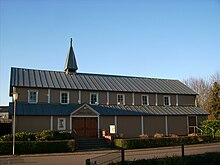Kripplein Christi (Glandorf)
Kripplein Christi is an Evangelical Lutheran church in Glandorf in the district of Osnabrück (Lower Saxony). It was built in 1912 as a timber frame construction in Holsen - Ahle ( Herford district ) based on the concept of Bodelschwingh's emergency churches and was moved to Glandorf in 1952.
history
Until 1945
Until the end of the Second World War, the population of Glandorf was Roman Catholic, with rare exceptions . The residents rejected the Low German as "Lutherske" designated Protestants from. The historical cause was the impact of the Thirty Years War on Glandorf. Swedish mercenaries set Glandorf on fire on May 5, 1636 and perpetrated atrocities on residents, including the mayor's family. The events of the 17th century remained in the memory of the Glandorf residents. The memory was renewed by the Heimatnovelle Schwedenchronik published in 1926 by the clergyman and writer Bernhard Köster , who was a priest in Glandorf from 1916.
Protestants move in
At the end of the war, Protestants from Silesia , Pomerania and East Prussia came to Glandorf through flight and expulsion ; the largest group were the Silesians. The new residents were looked after by the Evangelical Lutheran parish of what was then Flecken Iburg and mostly worked outside of the Klöckner steelworks in Georgsmarienhütte . First they held their services in the sacristy of the Catholic Church of St. Johannis , later moved to the Catholic school and for several years used the hall of the Brandes restaurant, which was often hastily prepared for the service on Sunday morning after the previous evening's celebrations. Around 1950, a piece of land belonging to the Gildehaus family on the outskirts of the town diagonally across from the former Theresienhospital was leased for their own church building and later bought. The services were held by the Iburg pastor Wilhelm Thimme until 1949 , followed by Günther Herbst in 1949.
Purchase of the emergency church
In 1952 the number of Protestants in Glandorf had risen to around 600. In the same year the emergency church from Holsen-Ahle was taken over for 7,000 marks , which had been built in 1912 according to the plans of the Bethel architect Karl Siebold (1854-1937). It was designed from the outset as a portable emergency church according to Friedrich von Bodelschwingh's specifications for a period of around 30 to 40 years. The emergency churches were made in Bethel. Another was built in Obernbeck in 1912 and moved to Sölde in 1914 , where it burned down in the 1940s.
The churches had wooden stands; a double layer of wooden boards with an intermediate layer of insulating cardboard formed the outer walls. The roof was made of galvanized pan sheets measuring half a meter by two meters. The emergency churches were manufactured in two sizes; the larger version of the church that was bought offered space for 248 people in the main building, with 75 places each in the separate community room and on the gallery. The roof of the church in Holsen-Ahle was already rusting in the 1930s, and the stands were rotten. Regardless of this, the church was dismantled and transported to Glandorf. There it was shortened by two lengthways elements and set up on a stone foundation within six weeks by members of the community in Glandorf. With the shortening, the church still had 300 seats. The bell came from the old Schierloh school. The first service was celebrated by Superintendent Brandes from the Georgsmarienhütte church district and Pastor Herbst from the Evangelical Lutheran Castle Church in Iburg on December 21, 1952 with the Glandorf parishioners.
The name of the church, which is unusual in north-west Germany, comes from the church in Fraustadt , now Wschowa, Poland, built by Valerius Herberger in the 17th century .
Since 1952
It was only in the course of the decades that the church was furnished in a contemporary way. Initially, water was brought in from the Theresienhospital in buckets. Until the late 1980s, the church had an external toilet without flushing. A coal stove was used for heating, and central heating was installed in the 1980s. In the mid-1970s, the church received an organ from Gebr. Oberlinger Orgelbau with five and a half registers. The simple furnishings include a cross that was created by the sculptor Siegfried Zimmermann (1927–2012) from Hanover. The church has been renovated several times, most recently extensively in 1997/1998. Hausbock infestation was also eliminated.
Since 1989 the church "Kripplein Christi" belongs to the Evangelical Lutheran Trinity Church Community of Bad Laer-Glandorf .
literature
- Rolf Westheider: The "Kripplein Christi" in Glandorf - From provisional to curiosity In: Heimatbund Osnabrücker Land e. V., Kreisheimatbund Bersenbrück e. V. (Ed.): Heimat-Jahrbuch 2010 Osnabrücker Land , pp. 234–242, ISBN 978-3-941611-10-8 .
Web links
Footnotes
- ↑ The previous sources of the article do not clearly prove whether it is Friedrich von Bodelschwingh the Elder or Friedrich von Bodelschwingh the Younger .
Coordinates: 52 ° 5 ′ 4.5 ″ N , 8 ° 0 ′ 12 ″ E
